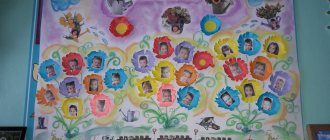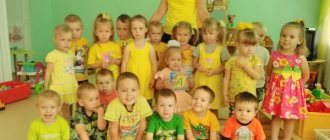Types of theatrical activities
Theatrical games in the senior group can be divided into two main types: dramatic and directorial. Children begin to master the second on their own when they play with toys: they control plush performers, speak for them, move them, and build relationships between toys.
The dramatic type of activity involves the child’s independent performance as an artist using various techniques of expressive speech.
Children as artists
Open classes
Open lessons on theatrical activities attract children with their naturalness. In the improvised auditorium sit not only familiar children and teachers, but also invited guests - parents and other teachers. The purpose of such a lesson is to demonstrate children’s involvement in art, the children’s ability to clearly and distinctly pronounce lines, and not be embarrassed by the audience.
Most often, such classes use costumes created by children together with their parents. Each child who takes part in the formation of his image becomes more closely connected with his character and is sensitive to his fate.
Catchy songs for kids to make dancing fun
Attention! Sometimes it is enough to let a preschooler decorate the mask of his hero so that he feels responsible for the fate of the character.
In some preschool institutions, during music classes, children are given cards with images of characters. Having each received their role, the guys play “Turnip”, “Kolobok” or “Teremok” to the accompaniment.
Drama games
Dramatizations allow preschool children to reveal their directing abilities. One student can control several characters at once, and children are often so carried away that they involuntarily adjust the intonation of their voice individually for each character. During such performances, children learn the significance of emotions and practice their facial and intonation demonstration. The definition of character is fixed - all the heroes in the fairy tale are different, each with their own temperamental characteristics.
It is not uncommon for teachers to put on several theatrical performances each season, reinforcing the study of nature and weather patterns through play. For example, in winter, children are invited to dramatize the process of preparing various animals for wintering: some fill bins with food, insulate their homes; others gorge themselves and hibernate, while others go to warmer climes.
Toy range for director's play
Self-analysis in planning theater activities
Experienced teachers, before drawing up an art teaching project for a year or a season, conduct a survey of parents, from which they learn about the degree of emotional liberation of the children, the clarity of the child’s speech at home, the ability to use facial expressions and gestures during communication and the inclinations to empathy .
After conducting the survey, the teacher becomes clear which aspects should be paid more attention to and which ones less when compiling a card index of theatrical games in the group.
Important! Self-analysis reveals the main directions in which the selected material should be worked on and identifies weaknesses in the emotional development of children.
Theater project in the senior group
Play theater should be a constant presence in children's lives. To do this, teachers keep notes on theater activities, where they distribute various types of performances, evenly distributed throughout the academic year.
The results of the lessons in the garden are:
- communicative development of children of different ages;
- familiarization with the history of the origin of the theater and its purpose;
- joint creation of props and stage images;
- increasing parents' attention to the creative activities of preschoolers;
- creating a screen for further use by children in independent theatrical performances.
Making your own actors
The theater design should reflect the needs of children's development in accordance with their age characteristics. Often, children need to give free rein to their imagination to organize their own theatrical performance. So, children 4-5 years old can quite successfully put on a show using only spoons. A healthy imagination is enough to mentally endow each spoon with appearance, character, and create a fictional image. Even at the stage of self-analysis, teachers find out the pupils’ ability to think outside the box, leaving the child, as if by accident, alone at the table with two or three spoons. Some children begin to get bored over time and look in the direction of their frolicking peers, while others, already in the first minute, take up spoons and begin to play with them like dolls.
Fine motor skills of hands in children from 2 to 3 years old
Additional Information! Children who are unable to create instruments for play from everyday objects using their imagination especially need theater, which will allow them to develop non-standard thinking and relieve them of emotional constraint.



